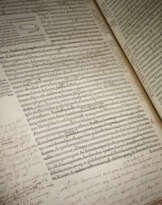ID 1129641
Lot 23 | Compendiosa totius Anatomie delineatio
Valeur estimée
$ 40 000 – 60 000
Crisp and fresh printing of the first edition of this famous engraved adaptation of Vesalius's anatomical illustrations. This was the first appearance of these images after Vesalius's Fabrica and Epitome in 1543, and became the chief source for the Vesalian images throughout Europe. The text is borrowed from the Epitome, as are the full-page figures, including the famous Adam and Eve engraving, while many of the smaller images are copied from the Fabrica. Thomas Geminus was a Flemish engraver who emigrated to England about 1540. He had previously lived in Padua and was a roommate of Vesalius there; he had also been a surgeon until 1555, when he was examined and penalized by the College of Physicians for practicing without a license. He introduced copperplate engraving into England, and this book is the earliest large-scale production in the new medium.
"Although by tradition and Vesalius’s own comments this work has been considered the first of the many plagiarisms of Vesalius’s Fabrica and Epitome, Geminus gave full credit to Vesalius in a bold headline on the first leaf of text. He did, however, redraw and engrave Vesalius’s woodcuts without permission (Garrison and Morton)." The medium of engraving actually allowed for sharper lines than the woodcuts in Vesalius's original, avoiding some of the legibility issues facing the more famous anatomist (see lot xx for more on this). Cushing notes that the nine figures of the female organs on plate 34 are the same as appeared in Raynolds’ 1545 Byrth of mankynde, considered the first English book illustrated with engravings. The engraved title page, the earliest English example of such an illustration, takes the form of a tableau glorifying Henry VIII. Henry, to whom the book is dedicated, had only five years earlier given assent to an act uniting Barbers and Surgeons into one company, authorizing the supply of four cadavers to them each year.
This copy has plates printed on all three watermarks recorded by Cushing, the jug, the gauntlet with star, and the letter ‘P’. Several of the smaller images are in fact composed of smaller plates, mortised together, and printed on a single sheet, as detailed by Cushing. The two venous and arterial plates are in the first state. Garrison and Morton 376.1; Cushing, Bio-bibliography of Vesalius VI C-2; Norman 886; Stillwell Science 645; see Mortimer French 541 and Hind, Engraving in England I, pp. 39-55 and plates 17-28. On the two issues of the venous and arterial plates see I.M.L. Donaldson, "Two States of Some Plates in the Compendiosa of Thomas Geminus (1545)," in The Library, v 11 (2010), pp. 89-104.
Folio (397 x 275mm). Engraved title, 40 engraved plates, one of which folding (margins of title frayed, not touching image, six plates with old paper reinforcement on blank versos, where the plate edge has cut into the paper, again not affecting images, a few incidental stains, heavier on last plate of surgical instruments (from poor plate wiping between impressions), some slight browning to some text leaves and a small area of marginal waterstaining). Contemporary calf gilt (rebacked and recornered). Provenance: half-page manuscript passage on the rear flyleaf discussing the attribution of the Vesalian images to Titian, with a transcription of a passage in Latin concerning the same – "Pauli Calderoni favent" (17th-century inscription on front flyleaf).
| Artiste: | Andreas Vesalius (1514 - 1564) |
|---|
| Artiste: | Andreas Vesalius (1514 - 1564) |
|---|
| Adresse de l'enchère |
CHRISTIE'S 20 Rockefeller Plaza 10020 New York Etats-Unis | ||||||||||||||
|---|---|---|---|---|---|---|---|---|---|---|---|---|---|---|---|
| Aperçu |
| ||||||||||||||
| Téléphone | +1 212 636 2000 | ||||||||||||||
| Fax | +1 212 636 4930 | ||||||||||||||
| Conditions d'utilisation | Conditions d'utilisation | ||||||||||||||
| transport |
Service postal Service de messagerie ramassage par vous-même | ||||||||||||||
| Modes de paiement |
Virement bancaire | ||||||||||||||
| Heures d'ouverture | Heures d'ouverture
|














